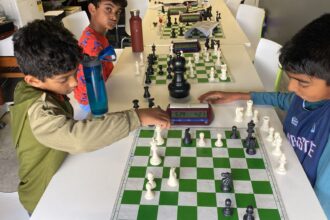Credits- Chess.com | Chess fans didn’t have to wait long for a decisive result in the 2023 FIDE World Championship, as GM Ian Nepomniachtchi convincingly took down GM Ding Liren in game two. Despite a successful-looking novelty by Ding on move 4, things quickly turned south for the first-time challenger and it took Nepomniachtchi merely 29 moves to take home the full point.
Game three begins on Wednesday, April 12, at 15:00 Astana time (2 a.m. PT/11:00 CEST) after a rest day.
The game entered into uncharted territory as early as move four when Ding opted for 4.h3 instead of going into a Catalan Opening, as may have been expected. The move prompted an immediate “No, he mouse slipped, the g-pawn is the other one!” from commentator Giri and a deep think from Nepomniachtchi. The move has never been played in top-level classical chess, although the position had been reached before in Meshkovs-Shuvalova 2022 during a Titled Tuesday event.
Asked at the press conference about this move, Ding confirmed that it was influenced by his second, GM Richard Rapport. Nepomniachtchi said that while he did not expect this move—in fact, he began recording 4.g3 on his scoresheet before realizing the h-pawn had been moved—he thought that it was still a “normal move” that didn’t pose many complications.
From the time spent by both players over the next few moves, it was clear that Ding was comfortably in his preparation, while Nepomniachtchi was certainly out of his. As mentioned on the broadcast, the difficulty this posed for Nepomniachtchi was that he was no longer “choosing off of a menu,” but rather choosing moves blindly against the 3600-rated engine that was behind Ding’s at-home preparation.
All seemed to be going well for the first-time challenger, until Black’s 11…Na5. After this move, Ding took over 20 minutes to return to the board, prompting concern from viewers and commentators, since even Nepomniachtchi returned to the board before his opponent did.
While Giri initially speculated that Ding was still in his preparation and was merely taking time to decide which move to choose, that theory was refuted as the first-time challenger’s time dropped below his opponent’s, and he eventually played 12.Nxf6 after a total thinking time of almost 34 minutes.






